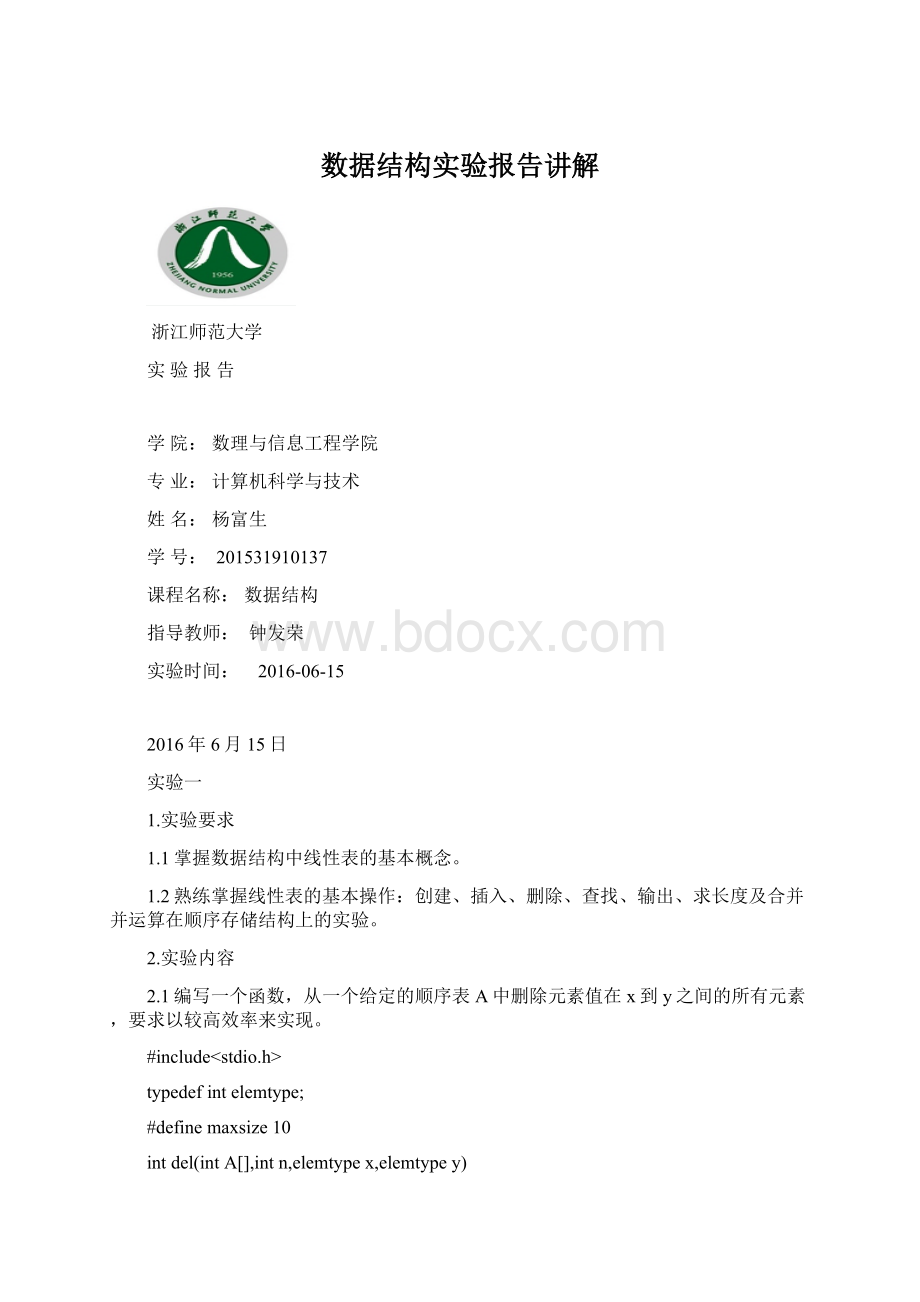数据结构实验报告讲解.docx
《数据结构实验报告讲解.docx》由会员分享,可在线阅读,更多相关《数据结构实验报告讲解.docx(31页珍藏版)》请在冰豆网上搜索。

数据结构实验报告讲解
浙江师范大学
实验报告
学院:
数理与信息工程学院
专业:
计算机科学与技术
姓名:
杨富生
学号:
201531910137
课程名称:
数据结构
指导教师:
钟发荣
实验时间:
2016-06-15
2016年6月15日
实验一
1.实验要求
1.1掌握数据结构中线性表的基本概念。
1.2熟练掌握线性表的基本操作:
创建、插入、删除、查找、输出、求长度及合并并运算在顺序存储结构上的实验。
2.实验内容
2.1编写一个函数,从一个给定的顺序表A中删除元素值在x到y之间的所有元素,要求以较高效率来实现。
#include
typedefintelemtype;
#definemaxsize10
intdel(intA[],intn,elemtypex,elemtypey)
{
inti=0,k=0;
while(i{if(A[i]>=x&&A[i]<=y)
k++;
else
A[i-k]=A[i];
i++;
}
return(n-k);
}
voidmain()
{
inti,j;
inta[maxsize];
printf("输入%d个数:
\n",maxsize);
for(i=0;iscanf("%d,",&a[i]);
j=del(a,maxsize,1,3);
printf("输出删除后剩下的数:
\n");
for(i=0;iprintf("%d"\n,a[i]);
}
2.2试写一个算法,在无头结点的动态单链表上实现线性表插入操作INSERT(L,i,b)。
voidInsert(Linklist&L,inti,elemtypex)
{
if(!
L)
{
L=(Linklist)malloc(sizeof(Lnode));
(*L).data=x;(*L).next=NULL;
}
else
{
if(i==1)
{
s=(Linklist)malloc(sizeof(Lnode));
s->data=x;s->next=L;L=s;
}
else
{
p=L;j=1;
while(p&&j{j++;p=p->next;}
if(p||j>i-1)
returnerror;
s=(Linklist)malloc(sizeof(Lnode));
s->data=x;s->next=p->next;p->next=s;
}
}
}
2.3生成两个多项式PA和PB,求他们的和,输出“和多项式”。
typedefstructnode
{intexp;
floatcoef;
structnode*next;
}polynode;
polynode*polyadd(polynode*pa,polynode*pb)
{
polynode*p,*q,*pre,*r;
floatx;
p=pa->next;
q=pb->next;
pre=pa;
while((p!
=NULL)&&(q!
=NULL))
if(p->exp>q->exp)
{
r=q->next;
q->next=p;
pre->next=q;
pre=q;
q=r;
}
else
if(p->exp==q->exp)
{
x=p->coef+q->coef;
if(x!
=0)
{p->coef=x;
s=p;
}
else
{pre->next=p->next;
free(p);
}
p=pre->next;
r=p;
q=q->next;
free(r);
}
else
if(p->expexp)
{
pre=p;
p=p->next;
}
if(q!
=NULL)
pre->next=q;
free(pb);
}
2.4设计一个统计选票的算法,输出每个候选人的得票结果。
typedefintelemtype
typedefstructlinknode
{
elemtypedata;
structlinknode*next;
}nodetype;
nodetype*create()
{
elemtyped;
nodetypeh=NULL,*s,*t;
inti=1;
printf("建立单链表:
\n");
while
(1)
{
printf("输入第%d个结点数据域",i);
scanf("%d",&d);
if(d==0)break;
if(i==1)
{
h=(nodetype*)malloc(sizeof(nodetype));
h->data=d;h->next=NULL;t=h;
}
else
{
s=(nodetype*)malloc(sizeof(nodetype));
s->data=d;s->next=NULL;t->next=s;
t=s;
}
i++;
}
returnh;
}
voidsat(nodetype*h,inta[])
{
nodetype*p=h;
while(p!
=NULL)
{
a[p->data]++;
p=p->next;
}
}
voidmain()
{
inta[N+1],i;
for(i=0;ia[i]=0;
nodetype*head;
head=create();
sat(head,a);
printf("候选人:
");
for(i=1;i<=N;i++)printf("%3d",i);
printf("\n得票数\n");
for(i=1;i<=N;i++)
printf("%3d",a[i]);
printf("\n");
}
3.实验心得体会
线性表是最简单的、最常用的一种数据结构,是实现其他数据结构的基础。
实验二
1.实验要求
1.1了解栈和队列的特性,以便灵活运用。
1.2熟练掌握栈和有关队列的各种操作和应用。
2.实验内容
2.1设一个算术表达式包括圆括号,方括号和花括号三种括号,编写一个算法判断其中的括号是否匹配。
#include
#include
#include
#defineNULL0
typedefstructlist
{
charstr;
structlist*next;
}list;
voidpush(char,list*);
intpop(char.list*);
voiddeal(char*str);
main(void)
{charstr[20];
printf("\n请输入一个算式:
\n");
gets(str);
deal(str);
printf("正确!
");
getchar();
return0;
}
voiddeal(char*str)
{list*L;
L=(list*)malloc(sizeof(list));
if(!
L)
{
printf("错误!
");
exit(-2);
}
L->next=NULL;
while(*str)
{
if(*str=='('||*str=='['||*str=='{')
push(*str,L);
else
if(*str==')'||*str==']'||*str=='}')
if(pop(*str,L))
{puts("错误,请检查!
");
puts("按回车键退出");
getchar();exit(-2);
}
str++;
}
if(L->next)
{puts("错误,请检查!
");
puts("按任意键退出");
getchar();exit(-2);
}
}
voidpush(charc,list*L)
{list*p;
p=(list*)malloc(sizeof(list));
if(!
p)
{
printf("错误!
");
exit(-2);
}
p->str=c;
p->next=L->next;
L->next=p;
}
#definecheck(s)if(L->next->str==s){p=l->next;L->next=p->next;free(p);return(0);}
intpop(charc,list*L)
{
list*p;
if(L->next==NULL)return1;
switch(c)
{
case')':
check('(')break;
case']':
check('[')break;
case'}':
check('{')break;
}
return1;
实验三
1.实验要求
1.1掌握二叉树,二叉树排序数的概念和存储方法。
1.2掌握二叉树的遍历算法。
1.3熟练掌握编写实现树的各种运算的算法。
2.实验内容
2.1编写程序,求二叉树的结点数和叶子数。
#include
#include
structnode{
chardata;
structnode*lchild,*rchild;
}bnode;
typedefstructnode*blink;
blinkcreat()
{
blinkbt;
charch;
ch=getchar();
if(ch=='')return(NULL);
else
{
bt=(structnode*)malloc(sizeof(bnode));
bt->data=ch;
bt->lchild=creat();
bt->rchild=creat();
}
returnbt;
}
intn=0,n1=0;
voidpreorder(blinkbt)
{
if(bt)
{
n++;
if(bt->lchild==NULL&&bt->rchild==NULL)
n1++;
preorder(bt->lchild);
preorder(bt->rchild);
}
}
voidmain()
{
blinkroot;
root=creat();
preorder(root);
printf("此二叉数的接点数有:
%d\n",n);
printf("此二叉数的叶子数有:
%d\n",n1);
}
2.2编写递归算法,求二叉树中以元素值为X的结点为